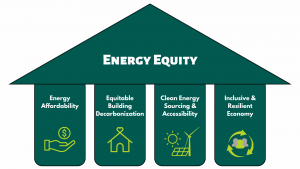Energy for Everyone: What is energy equity and how do we achieve it?

I grew up in a small desert town two hours east of Los Angeles called Hesperia. In 2002, my family was the first in our Southern California neighborhood to get solar panels. I was fascinated by what my mother described as “free money from the sun,” and watching those blue panels go up was my first step into the field of renewable energy. Twenty years later, I’ve learned there are layers to solar energy beyond my mother’s words, from the unethical mining of precious metals in international communities to the cost burden that low-income households shoulder due to net energy metering in California.
Low-income communities and communities of color have historically been locked out of the benefits promised by the transition to clean energy. To make matters worse, these communities experience active and ongoing harm from the fossil fuel industry. But we have an opportunity before us to center equity in the burgeoning clean energy economy and maximize benefits for low-income communities and communities of color. If we get this right, we can create healthier living conditions, eliminate energy burdens, and provide opportunities for wealth-building.
WE HAVE AN OPPORTUNITY BEFORE US TO CENTER EQUITY IN THE BURGEONING CLEAN ENERGY ECONOMY AND MAXIMIZE BENEFITS FOR LOW-INCOME COMMUNITIES AND COMMUNITIES OF COLOR.

In my first couple of months at Greenlining as the Energy Equity Program Manager, I began to draft what our road to achieving this vision could look like. I asked over 50 energy and environmental justice experts for their definition of “energy equity.” The image to the right represents an aggregate of their responses. One term came up repeatedly: multi-faceted.
Energy is an expansive field that spans generation-whether from a wind farm or a nuclear power plant-to how people use energy to power things like home appliances and industrial manufacturing. And, every level of the energy industry could bring new opportunities for reliability, affordability, and accessibility for the most disinvested communities. With the slew of new energy and climate bills passed in 2022 in California and at the federal level, the distribution of funding and implementation of these policies presents another opportunity for advancing equity.
Thanks to conversations with community and coalition partners, we’ve honed an energy equity strategy built on four foundational pillars; energy affordability, equitable building decarbonization, clean energy sourcing & accessibility, and building an inclusive and resilient economy.

ENERGY AFFORDABILITY
Energy is a human right. Community organizations I spoke with shared the compounding issues that people faced–most notably: affordability. Excessive utility debt can lead to people losing their home with no alternative housing paths in a harmful cycle. This is unacceptable. Part of our team’s work will be to continue our advocacy efforts on utility debt relief, where we’ve worked with organizations, like SCOPE LA and TURN, to help secure $1.2B for electric utility debt in California’s budget.
We will also work to reduce the energy bills of low-income households in California through energy rate reform. Last Thursday, the California Public Utilities Commission (CPUC) released a proposed decision on net energy metering or NEM, a program that allows Californians with solar to receive credit on their bills for the energy they export to the grid. The proposal seeks to restructure the pricing structure of NEM participants to incentivize solar plus storage systems and other home electrification measures while making rates more affordable for all.
One of the drivers behind the proposed decision was an analysis of NEM 2.0, an existing program that shows that non-participating low-income ratepayers end up disproportionately shouldering fixed costs of the program compared to existing solar customers in typically higher-income brackets. This cost shift is estimated to have led to a $3.37B burden on non-participant ratepayers in 2021, which would have continued to grow if not intentionally addressed as it is in the new proposed successor tariff structure. There are still many questions to be worked through, such as how the $630M of funding allocated to the CPUC from the California State Budget for low-income customers to install solar energy storage systems will be distributed.
To be clear, NEM was a helpful tool in order to achieve the levels of solar adoption we see in California but it is also clear that NEM disproportionately burdens low-income customers for the cost of this adoption in predominantly higher-income households. California’s first try at NEM demonstrated the need for measures that protect energy affordability as solar becomes more accessible to lower-income households. But, we will need even more tools and resources to protect energy affordability in the future. As we work to figure out what these measures are, it is important to recognize that while this is an affordability issue, it is also a human issue, and we must prioritize those most impacted as California grows as a national solar leader.
EQUITABLE DECARBONIZATION
Another hot topic is building decarbonization, or reducing greenhouse gas emissions from buildings which contribute to 25% of California’s greenhouse gas emissions. This is achieved in different ways, both by reducing energy demand as well as by electrifying appliances that rely on fossil fuels like natural gas or propane. But electrifying a home comes with a steep price tag. As cities and state agencies across California enact stricter laws requiring homes to electrify, it’s becoming increasingly critical to protect low-income residents from escalating cost burdens.
We published the Equitable Building Electrification Framework which lays out policy considerations for equitable electrification through meaningful community engagement, equitable metrics and evaluation, tenant protections, and workforce considerations. With California allocating almost $1B for the California Energy Commission (CEC) to establish an equitable building decarbonization program, and the Biden Administration investing almost $50B in building electrification through the Inflation Reduction Act, it is imperative to ensure these programs are implemented equitably, taking into account the challenges and priorities of low-income communities and communities of color.
I spoke with Denaya Shorter from the Ecology Center who noted the misconception in the industry that “…marginalized and BIPOC communities, we don’t know or are not interested.” This is simply not true and we have to fight to dispel this myth at every stage, including educating policymakers on HOW to engage with communities and bridge those information gaps.
CLEAN ENERGY SOURCING AND ACCESSIBILITY
Our third pillar, clean energy sourcing and accessibility, is what originally drew me to the energy field. In my undergraduate years studying environmental engineering, I learned about the environmental impacts of sourcing fossil fuel energy versus renewable energy sources. It was clear then and remains true now that the use of fossil fuels leads to harmful pollution that not only exacerbates climate change everywhere but disproportionately impacts low-income communities and communities of color with worse health outcomes. Unfortunately, there are still too many fossil fuel power plants, oil wells, and natural gas-powered homes in California communities, harming people and children.
THERE ARE STILL TOO MANY FOSSIL FUEL POWER PLANTS, OIL WELLS, AND NATURAL GAS-POWERED HOMES IN CALIFORNIA COMMUNITIES, HARMING PEOPLE AND CHILDREN.
In the upcoming year, Greenlining’s energy equity team will continue to advocate for a just transition from fossil fuels to renewable energy, as well as convey concerns about emerging energy sources. California introduced several new goals for clean energy in this year’s legislative cycle including policy on carbon capture, utilization, and sequestration (CCUS), green hydrogen, and a decision on the state’s sole remaining nuclear power plant. One of our key priorities will be to track plans and regulations on CCUS at state agencies and uplift community voices in a local CCUS project planned in Stockton. Our team is also pushing to expand low-income customers’ access to renewable energy with community solar programs.
INCLUSIVE AND RESILIENT ECONOMY
The last pillar of our energy equity strategy is to build an inclusive and resilient clean energy economy, where people from low-income communities and communities of color have access to new green jobs and wealth-building opportunities. Our team supports creating intentional pathways through workforce programs, higher education, and union partnerships to increase diversity in the clean energy industry and support workers’ transition out of the fossil fuel industry. As part of this effort, we will continue Greenlining’s role in facilitating the CEC California Sustainable Energy Entrepreneur Development Initiative (CalSEED) program and help guide clean energy entrepreneurs to center equity in their innovative work. With an “Equity-In; Equity-Out” framework, Greenlining works with CalSEED to conduct inclusive outreach, create a fair and equity-focused awardee selection process, provide training to awardees, and develop a robust equity evaluation of the program.
LOOKING AHEAD
There is huge momentum in the climate and energy space and it is vital to ensure that new policies and programs are shaped to create the best equity outcomes. Agustin Cabrera, the Policy Director at our coalition partner organization SCOPE LA, sums it up when saying “We need to really take a step back and create a process where we’re engaging frontline communities, workers, renters in these [climate policy] conversations so we can derive a more community-led response.” With this in mind, our team will continue to reinforce that the only option for California’s transition to clean energy is a just transition where the needs of communities are prioritized every step of the way.
Reach out to me at fatima.abdul-khabir@greenlining.org if you have any questions or recommendations.




